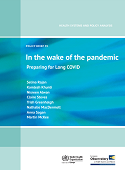In the wake of the pandemic: preparing for Long COVID (2021)

Download
This brief’s key messages are:
- COVID-19 can cause persistent ill-health. Around a quarter of people who have had the virus experience symptoms that continue for at least a month but one in 10 are still unwell after 12 weeks. This has been described by patient groups as “Long COVID”.
- Our understanding of how to diagnose and manage Long COVID is still evolving but the condition can be very debilitating. It is associated with a range of overlapping symptoms including generalized chest and muscle pain, fatigue, shortness of breath, and cognitive dysfunction, and the mechanisms involved affect multiple system and include persisting inflammation, thrombosis, and autoimmunity. It can affect anyone, but women and health care workers seem to be at greater risk.
- Long COVID has a serious impact on people’s ability to go back to work or have a social life. It affects their mental health and may have significant economic consequences for them, their families and for society.
- Policy responses need to take account of the complexity of Long COVID and how what is known about it is evolving rapidly. Areas to address include:
- The need for multidisciplinary, multispecialty approaches to assessment and management;
- Development, in association with patients and their families, of new care pathways and contextually appropriate guidelines for health professionals, especially in primary care to enable case management to be tailored to the manifestations of disease and involvement of different organ systems;
- The creation of appropriate services, including rehabilitation and online support tools;
- Action to tackle the wider consequences of Long COVID, including attention to employment rights, sick pay policies, and access to benefit and disability benefit packages;
- Involving patients both to foster self-care and self-help and in shaping awareness of Long COVID and the service (and research) needs it generates; and
- Implementing well-functioning patient registers and other surveillance systems; creating cohorts of patients; and following up those affected as a means to support the research which is so critical to understanding and treating Long COVID.





















